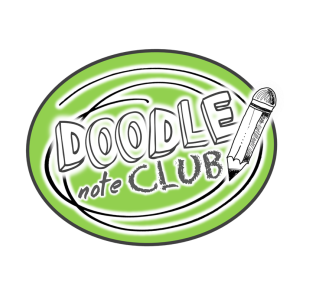This example is a case study of a doodle note page created by one of our members, Jennifer.
We wanted to share the before and after of her visual trigger with you so you could see a step-by-step example of improving on a visual analogy. (Remember, these are graphics that help a big-picture concept really stick in your student’s brains.)
First, check out Jennifer’s first draft of her page:
BEFORE:

She did an awesome job embedding a variety of student tasks (fill in the blanks and a “try it” sample question, plus plenty of opportunities throughout to color and doodle).
She also has some really great graphics included.
The key change she made to her page was to maximize her visual for the big idea. Notice that in this “before” version, she has a small bridge as a graphic under “Reasoning.” It says, “Reasoning forms a bridge that connects the claim and the evidence.”
Since this is the main idea that helps students understand the connection between the key parts of the scientific explanation, Jennifer turned it into a larger visual analogy (see the “After” picture below).
This “bridge” idea is the key to understanding the relationships and then being able to write a clear scientific explanation, which is Jennifer’s main goal for her students during this lesson.
AFTER:

Now, the graphic takes a bigger role, plus it has become a student task!
Student Interaction with the Bridge Analogy:

The students can now interact with this visual analogy, transforming it into a stronger memory trigger.
The answer key (shown up close, above) displays a sample of how students can use lettering to complete the graphic in a way that helps them connect the ideas and retain the information.
Jennifer had to shrink down the shield-shaped container for “reasoning” to fit this, but it worked out great!
Need more detail? Here’s how we made the new graphic:
First, I grabbed the following images from openclipart.com (public domain, so feel free to use them!) I specifically narrowed my search by looking for images that could be written inside of, to allow for student interaction with the key terms.
![]()



I tend to download any options I think may work, and save them to my desktop, so I grabbed two bridges at first. As I played around with the graphics, I decided I liked the idea of having students write one letter per wooden board on the bridge, so I trashed the second bridge image.
I chose hills, but the bridge could have also been between two towers, two trees, etc. If you have a preference based on your lesson, choose your own graphics based on that. Otherwise, just use whatever graphics you can find and edit easily.
To create the bridge for the final graphic, I cropped a couple of wooden boards off of both ends of the first bridge to allow for 9 letters (the number of letters in “reasoning”).
Then, I converted it to black and white.
When I inserted the hills on each side, the black and white option did not turn out well. I wanted an empty center for students to write and/or draw inside of. So instead, I used a greyscale from the recoloring options, and added a black glow around it.
I selected all three images and saved as a png to insert onto the page. This whole process took about 3-4 minutes.

Hopefully, this example will help you with your own next page. If you can think of a great analogy or graphic for your lesson (like Jennifer’s “bridge” idea), make it a goal to stretch that one step further into a graphic like this one that allows for student interaction beyond just coloring.
This way, you can form your own visual memory trigger that also has a student task embedded right into the graphic.
Thanks so much to Jennifer for being willing to share this particular example to help those who sometimes get stuck in the same way! This page on Scientific Explanations is available in the Share Zone for those who teach this topic (Thanks again to Jennifer!) Enjoy!

https://waterfallmagazine.com
I truly love your blog.. Great colors & theme. Did you develop this site
yourself? Please reply back as I’m hoping to create my own personal
blog and want to find out where you got this from or just what the theme is named.
Thanks!
Hi! Thanks for the comment. Yes, this website was developed from scratch using bluehost.com and WordPress as our hosting site! Best of luck to you!